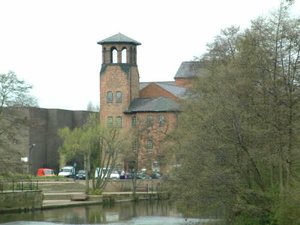Derby Industrial Museum
|
|
The Derby Industrial Museum is housed in a former Silk Mill in Derby, England. Between 1717 and 1721 George Sorocold built Britainís first mill for the Lombe brothers, beside the River Derwent. This mill was built to house machines for "doubling" or twisting silk into thread.
John Lombe copied the design for the machines used for spinning large quantities of silk, during a period spent in Italy, working within the Italian Silk Industry. This was possibly the first example of Industrial espionage.
Traditionally the spinning wheel had been used for producing small quantities of silk thread at the homes of local spinsters, the new large, machines were capable of producing far greater quantities of silk and were to become serious competition for the Italians. These machines however required large buildings and a considerable power source. An undershot wheel turned by the mill fleam on the west side of the new Silk Mill drove the massive spinning machines.
John Lombe died in 1722 under mysterious circumstances, and was believed to have been poisoned by an Italian assassin in retribution for stealing their trade secrets. His half brother, Sir Thomas Lombe Knt., died June 2, 1739 leaving his estate to his widow and their two daughters.
Modelsilkmill.jpg
Dame Elizabeth advertised the lease for sale in 1739 the remaining 64 years of the lease were assigned to Richard Wilson junior of Leeds for £2,800. Richard Wilson remained in Leeds leaving the running of the mill to his partners, William and Samuel Lloyd, both London merchants, with Thomas Bennet as salaried manager, taking a proportion of the profits.
A description of the mill by William Wilson dating from sometime between 1739 and 1753 has survived: The original "Italian" works of five storeys high housed 26 Italian winding engines that spun the raw silk on each of the upper three floors whilst the lower two storeys contained eight spinning mills producing basic thread and four twist mills.
The Silk Mill was the first in Britain, was one of the tourist attractions of Derby and was visited by Boswell in September 1777. Not all the visitors were impressed by conditions. Torrington commented on the "heat, stinks and noise", whilst Fairholt in 1835 was appalled by the sickly appearance of the poor children. Foreign visitors also included the mill in their itinerary.
William Hutton was amongst the employees and he later recalled the long hours, low wages and beatings. Work only stopped in time of drought, extreme frost or problems with the silk supply although unofficial holidays were taken during elections and Derby races in August 1748.
The partnership of Wilson and Lloyd ended in 1753 after acrimony and legal suits. Lloyd remained in possession of the building and machinery. In 1765 Thomas Bennet bought the premises from Lloyd subject to a mortgage to the Wilson family but neglected the building during years of trade recession and competition from other mills in Derby and Cheshire.
Lamech Swift became the subtenant in 1780 paying an annual rent of £7 the Corporation and £170 to Thomas Wilson, brother of Richard and William. Despite a row with the Corporation over repairs to the weirs in 1781, he remained in occupation until the lease expired in 1803.
The Corporation advertised the lease in 1803 to run for 60 years. The advertisement reveals that the whilst the "Italian works" was still used for throwing silk,.
November 1833 saw the beginning of industrial unrest in Derby instigated by the Grand National Trades Union. Taylorís Silk Mill was not at the centre of the controversy although he was one of the employers who agreed not to employ any worker who was a union member. By the middle of April 1834 Taylor reported that two-thirds of his machinery was working and many of his former workers were applying for reinstatement. According to "The Derby Mercury" some of the former unionists were never able to find fresh employment in Derby.
The Taylor family remained in occupation of the mill until 1865 when bankruptcy forced them to sell their machinery and lease. "The Derby Mercury" advertised several silk mills for sale that year and it were obvious that a general slump was hitting the industry. This took place four years before the Cobden Treaty with France which it is said to have effectively destroyed the British silk industry.
The long connection with silk production ended in about 1908 when F.W. Hampshire and Company, the Chemists, moved into the premises to make fly papers and cough medicines. On December 5, 1910 at 5.00 am, fire broke out in the adjacent flour mill of Sowter Bothers and soon engulfed the Silk Mill. The mill's east wall fell into the river and the whole building was gutted. Great efforts were made by the Borough Fire Brigade and the Midland Railway Company who saved the shell of the tower and the outline of the doorways leading into the original five floors. These can still be seen today on the tower staircase. The building was rebuilt at the same height but with three storeys instead of five and remains that way today.
During the 1920ís the building passed ownership to the Electricity Authority. They used partly as stores, workshops and a canteen. Hidden from the road by the power station, the millsí existence was largely forgotten by the general public until the power station was demolished in 1970. It was then adapted for use as Derbyís long proposed Industrial Museum, which opened on November 29, 1974.
Sources of information: Derby Industrial Museum, Derby Evening Telegraph and Derby Library Service.

